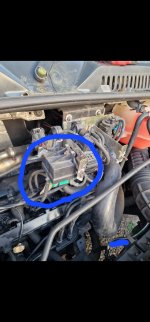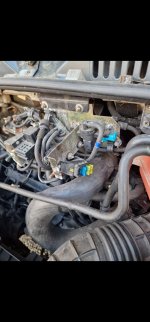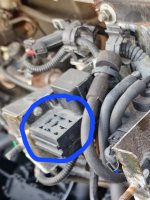The correct title is "split charge relay", In reality, as perhaps you are aware it is nothing magical. It connects the habitation and starter batteries in parallel when the engine is running.
The relay unit indicated seems more akin to a glowplug relay.
The fuses shown (2 x 20A & a 15A are probably for the two batterries, and the fridge (15A). I would expect the two 20A fuses to be for the two batterries and if so shoulld be connected to terminals 30, and 87 of the split charge relay.
Your photo shows two adjacent relay sockets, with one being empty. Concentrate your efforts in this area, as I would expect to see a fridge relay adjacent to a split charge relay on this type of installation.
The relay coils (terminals 86 & 85) may be connected in parallel, and one side 85? should be to chassis. The other terminal (86?) should be connected to D+. An alternative is to power the split charge relay via the fridge relay contacts. This reduces the load on the sensitive D+, alternator field circuit.
The fridge 15A fuse should ideally connect between the starter battery and the fridge relay contact 30, with 87 on the same relay going to the fridge 12V element.
May I suggest some wire tracing around those three fuses. Disconnect both battery negatives before doing any work, as both sides of the split charge relay are normally live at 12V, You seem to be missing a relay.
All of the relays should be covered by a plasic hood, which is normally secured to the two M6 forward facing studs.
Given the year 2003, your vehicle is most probably an x244 model (2002 - 2006). Confirm with first three numbers of VIN e.g. ZFA244..........
eLearn for the x244 runs on a Windows computer, and can be purchased as a CD for about £5, or downloaded from the forun "Downloads" section, for which see black ribbon at top of page.
Edit.
I note that the vehicle is a Swift conversion. Swift typically use Sargent manufactured electrical systems for the habitation system. Sargent are consistent with their wire colour coding.
Brown/Green = Starter Battery
Brown/Blue = Habitation (Leisure) Battery
Red/Yellow = Fridge
White/Orange = Earth
Blue = Vehicle D+





